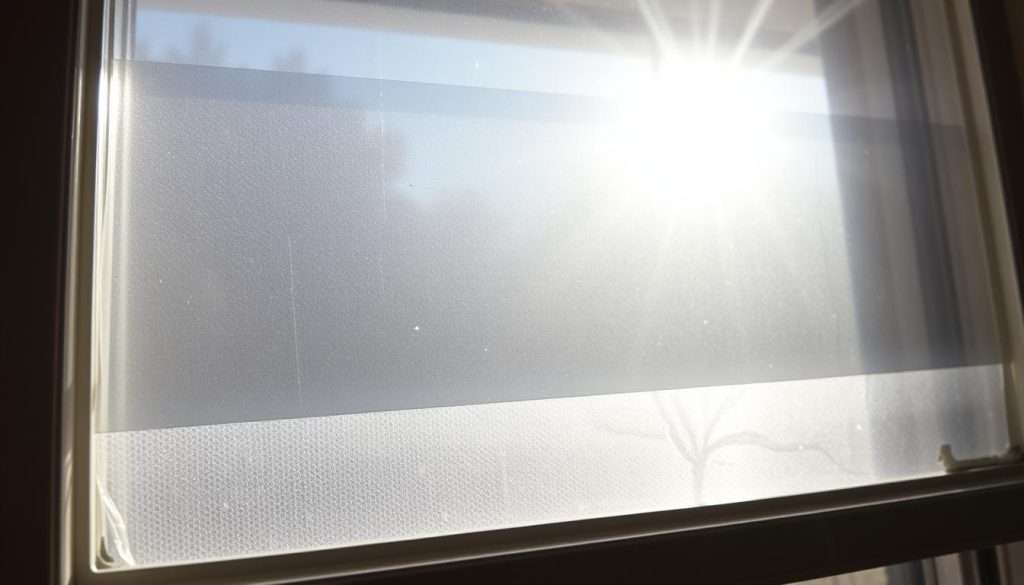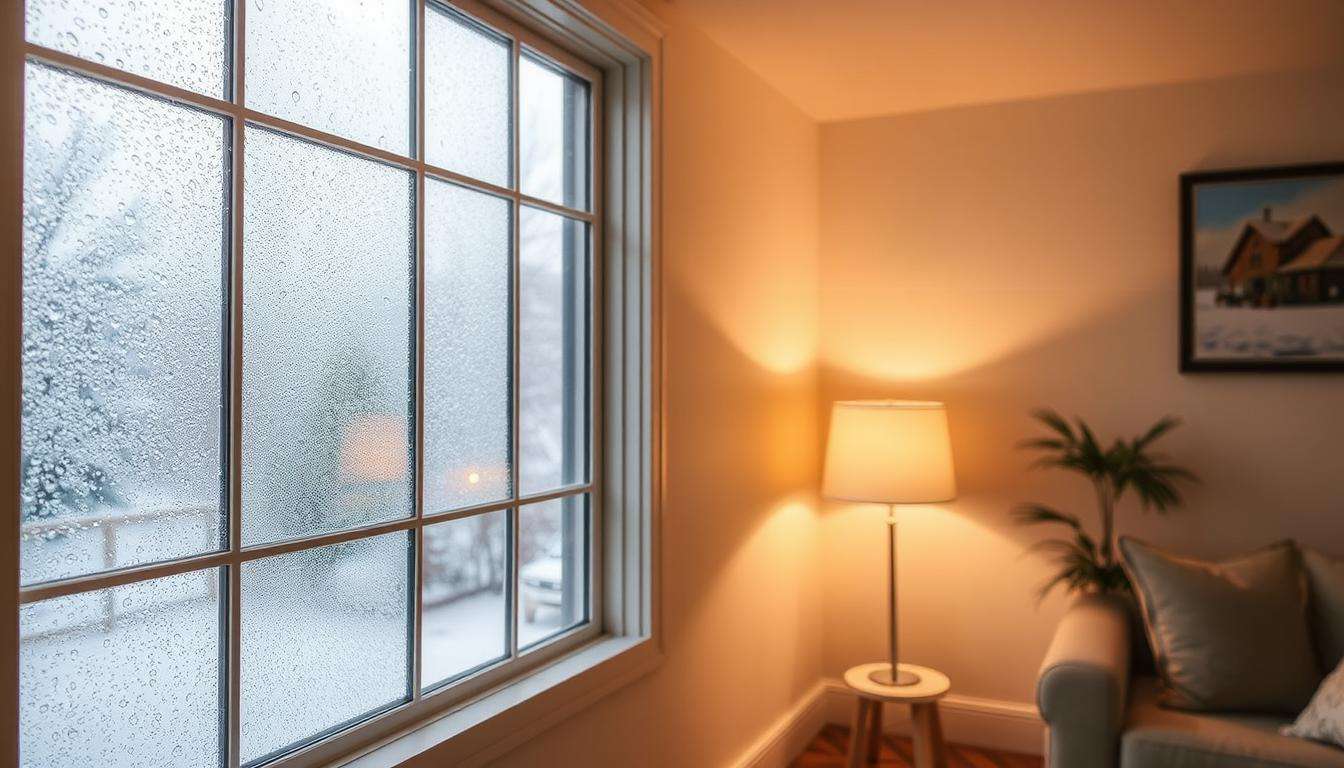Do you have high energy bills because of your windows? You’re not alone. Many people struggle with this. Window insulation film is a common solution.
In this guide, we’ll see if window insulation film really works. We’ll talk about its purpose, types, benefits, and how to install it. This will help you understand if it’s good for your home.
Window insulation film can be a great help during cold winter months. It can save you money on heating. These kits cost about $10 to $30 per window. They’re cheaper than replacing windows or getting more permanent solutions.
Key Takeaways
- Window insulation film can improve energy efficiency in older or single-pane windows.
- These kits are affordable, costing approximately $10 to $30 and allowing for seasonal adjustments.
- Using window insulation film can help reduce heating costs during winter months.
- Window kits offer temporary solutions enhancing comfort without long-term commitments.
- Improving your window’s R-value can significantly impact your home’s energy efficiency.
What Is Window Insulation Film?
Window insulation film makes your home more energy efficient. It stops heat from moving in and out. This keeps your home comfy all year.
This film is thin and made of polyester or PET. It goes right on your windows. Its main job is to save energy, which means lower bills.
Definition and Purpose
Window insulation film is a thin layer that blocks cold and heat. It keeps your home warm in winter and cool in summer. This is great for homes with drafty windows or high energy bills.
It makes your home more comfortable. And it’s also good for your wallet because it saves energy.
Types of Window Insulation Film
There are many types of window insulation film. Each one is made for different climates and needs. Here are a few:
- Solar Control Film – This film reflects heat and absorbs UV rays. It’s perfect for hot places, helping you save on cooling costs.
- Convection Control Film – This film stops heat from moving by creating a gap. It’s great for cold areas in winter.
Choosing the right window insulation film is key to a more energy-efficient home. Think about what you need, how long it will last, and how it looks. These things help you pick the best film for your windows.
| Type of Film | Climate Suitability | Main Benefit |
|---|---|---|
| Solar Control Film | Hot Climates | Reduces cooling costs by reflecting heat |
| Convection Control Film | Cold Climates | Minimizes heat loss with an air gap |
How Does Window Insulation Film Work?
Window insulation film helps make your home more energy efficient. It works by stopping heat from moving in and out. This makes your home more comfortable.
Mechanism of Insulation
Window insulation film creates a barrier. It traps air between the film and the window. This air is a great insulator.
For example, air is much better at keeping heat in than glass. Solar control films block UV rays and keep out heat. Convection control films help keep heat in during winter.
Energy Efficiency Benefits
Using window insulation film can save you money. It keeps your home warm in winter and cool in summer. This means you use less energy for heating and cooling.
It can even cut down your heating costs by up to 30%. This makes your home more comfortable and saves money.
| Type of Film | Function | Heat Reduction | UV Protection |
|---|---|---|---|
| Solar Control Film | Manages sunlight and heat gain | Absorbs 65% of light | Blocks 99% of UV rays |
| Convection Control Film | Prevents heat loss in winter | Enhances retention by up to 55% | Limited UV protection |
| Double-Glazing Film | Creates thermal barrier | Further reduces heat loss | Up to 99% protection available |
| Triple-Glazing Film | Superior insulation | Offers best retention | Includes UV protection |
Benefits of Using Window Insulation Film
Window insulation film is great for making your home better. It helps keep your home cozy and saves energy. Knowing its benefits can help you choose the best way to improve your home.
Cost-Effectiveness
Choosing window insulation film is a smart move. It’s cheaper than replacing windows. Prices range from $2 to $100 per square foot. You can even do it yourself with a kit for just $15.
It can save you money on energy bills. In hot places, it can cut cooling costs by 30%. In cold places, it can save up to 30% on heating.
UV Protection
Window insulation film also blocks UV rays. It can block up to 99% of them. This keeps your furniture, floors, and art from fading.
It makes your decor last longer. It also makes your home healthier by reducing UV rays inside.
Noise Reduction
Another great thing about window insulation film is it reduces noise. It’s perfect for people in loud cities or neighborhoods. It makes your home quieter and more peaceful.

| Benefit | Details |
|---|---|
| Cost-Effectiveness | Costs $2 to $100 per square foot; DIY kits starting at $15; ROI within 3 years through reduced energy bills. |
| UV Protection | Blocks up to 99% of UV rays, preventing furniture and flooring from fading. |
| Noise Reduction | Creates a barrier against outdoor noise, enhancing indoor tranquility. |
Comparing Window Insulation Film with Other Methods
Looking to make your home more energy efficient? There are many ways to do it. Let’s compare window insulation film with other choices like replacing windows, adding storm windows, and using insulated glass units.
Window Replacement
Replacing your windows is a big step. It can make your home much more energy efficient. But, it’s a costly option. It might not fit your budget.
Storm Windows
Storm windows add an extra layer to your windows. They help block drafts and keep your home warm. But, they cost more than window insulation films. They also need a pro to install them right.
Insulated Glass Units
Insulated glass units are a top choice for lasting energy savings. They are very good at keeping your home warm or cool. But, they are expensive. This might stop some people from choosing them.
Installing Window Insulation Film
Starting to install window film can make your home more energy efficient. Doing it yourself saves money and is fun. Just follow these steps to put window insulation film on your windows.
Step-by-Step Installation Guide
The process has six main steps:
- Clean the window well to stick the film right. Use rubbing alcohol, methylated spirits, or white spirit to get rid of grease and dry it.
- Measure and cut the film, leaving a bit extra for fitting.
- Put double-sided tape on the window frame. Press it down hard to stick it well.
- Put the film on the tape, starting from a corner. Don’t pull it too tight to keep it sticking.
- Smooth the film slowly to avoid air bubbles, adjusting as you go.
- Use a hair dryer to shrink the film, getting rid of wrinkles and fitting it tight.
Tools and Materials Needed
To do the job right, you’ll need these tools and materials:
| Item | Description |
|---|---|
| Window Film Kit | Includes plastic film for DIY on windows. |
| Double-Sided Tape | To stick the film to the window frame. |
| Tape Measure | For measuring windows before cutting the film. |
| Scissors | For cutting the film to size. |
| Hair Dryer | To shrink the film after, for a good fit. |
By following these steps, your window film will work better and last longer. It makes your windows more energy efficient. With a few tools and some patience, you can make your home more comfy.
Common Mistakes in Application
Putting on window insulation film can be fun, but mistakes can happen. Knowing these mistakes helps you do it right. This way, you get the best results without trouble.
Not Preparing the Surface
Not cleaning the window well is a big mistake. It’s key for the film to stick right. Dust, dirt, or old stuff can make it peel off. So, clean it well before you start.
Don’t use rubbing alcohol. It can leave stuff behind that stops the film from sticking.
Incorrect Measurements
Measuring wrong is a big problem. It can mean not enough film or too much waste. This can make you upset and cost more money.
Make sure to measure each window right. This way, you’ll have enough film for a perfect fit.
Failure to Smooth Out Wrinkles
After putting on the film, fix any air bubbles or wrinkles. Not doing this makes it look bad and doesn’t work well. Use a squeegee to smooth it out.

How to Maintain Window Insulation Film
Keeping your window insulation film in good shape is key. It helps it work better and last longer. Here are some tips for keeping it clean and knowing when to replace it.
Cleaning Tips
To keep your window insulation film clear and working well, clean it often. Here’s how:
- Use a soft cloth or sponge.
- Mix mild soap with water for cleaning solutions.
- Avoid harsh chemicals that could damage the film.
- Gently wipe the film to remove dust and grime.
These easy steps keep the film looking and working great. For more info on using and caring for window insulation films, see this installation guide.
Longevity and Replacement
Window insulation film usually lasts up to ten years. Its life depends on its quality and how much sun and moisture it gets. It’s important to check on it often. Here are signs it might need to be replaced:
- Visible cracks or bubbles in the film
- Reduced clarity affecting visibility
- Increased drafts around window edges
Fixing these problems early can save you money on energy. Ignoring damaged insulation can make your heating and cooling bills go up.
Assessing Energy Savings
Understanding energy savings from window insulation film is more than just the cost. It shows how it can lower your utility bills over time. By comparing energy use before and after, you can see the real benefits.
Measuring Your Savings
Start by tracking your energy costs before you put on the insulation film. Then, compare it over several months after. This shows how much you save and if the film works well. 3M has a tool to help figure out your savings.
For example, you could save up to $20 per window each winter. This depends on your furnace and local weather.
Impact on Utility Bills
After installing window insulation films, you’ll likely see your bills drop. Many people notice a big cut in heating and cooling costs. This means you get your money back quickly.
In cold places, windows can lose up to 60% of heat. Insulation films help keep this heat in. This makes your home more energy-efficient. Checking your energy use often ensures the film keeps working well.
| Type of Window Film | Potential Energy Savings Per Window (Winter) | Reduction in Cooling Load |
|---|---|---|
| Plastic Window Insulation Film | $20 | 27.5% |
| Albeedo Insulation Film | Varies by window type | 50% solar transmittance reduction |
| 3M Window Film | Varies by installation | 44% shading coefficient reduction |
Conclusion: Final Thoughts on Window Insulation Film
Window insulation film really works. It helps homes use less energy by keeping heat in and sun out. This means you pay less for energy.
Windows can lose a lot of heat, up to 30%. But, using film can stop this. It keeps your home warm or cool, making it more comfy all year.
Overall Effectiveness
Window film makes old windows work like new ones. It saves money on energy bills. This is good for your wallet.
It can cut your energy costs by 25%. This means you can spend that money on other things. It’s a smart choice for saving money.
Recommendations for Homeowners
Think about what you need before you start. Know your home’s climate and window condition. Clean and measure well for the best results.
Window film is a smart pick for saving energy and money. It also keeps your home safe from UV rays.
